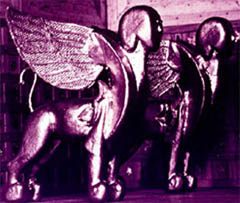David
and Solomon
Uniting
all Israelite tribes under his command, King David takes the
Fortress of Zion, renames it 'City of David,' and makes it the capital of
a united kingdom.
The Ark of the Covenant and the temple built by Solomon lay the foundations
for the connection between Jerusalem and YHWH, the God of Israel.
City of Judah
After
the death of Solomon, the united kingdom falls apart. Only Judah retains Jerusalem as its capital.
When, in 722,
the Northern Kingdom (Israel) is destroyed and, twenty years later, Jerusalem is spared
a similar fate, King and prophet attribute this miracle to YHWH's particular providence.
Judah soars as a border state of Assyria and briefly attains independence, only to be destroyed by the neo-Babylonians (Chaldeans).
City
of Temple and Torah
Against
the resistance of its current inhabitants, the hill country of Judah and Jerusalem
are gradually resettled by the returnees from exile. The walls are rebuilt
by Nehemiah. Ezra, priest and scribe, institutes the Torah as the constitution
of a priestly theocracy. Jerusalem is the center of the Persian satrapy of
Yehud.
Hellenistic
Polis
Alexander the Great brings Hellenization.
Some Greeks praise the Jews for the sublimeness of their religion, others
loathe them for resisting Hellenic style. Under the Seleucids, forced Hellenization
leads to the Maccabean revolt and the institution of a second Judahite dynasty,
the Hasmoneans.
Jerusalem
and Rome
Pompey's arrival marks the beginning of the end of Jewish dominion
over Jerusalem, but not before architecture and cultural life
attain their greatest level of sophistication yet. Herod enlarges the platform of the Temple to accomodate hundreds of thousands of pilgrims at a time.
| Holy
City: Jerusalem in time, space and imagination |
 |
|
Zion: City of Judah (c1000BCE-135CE) |
|

